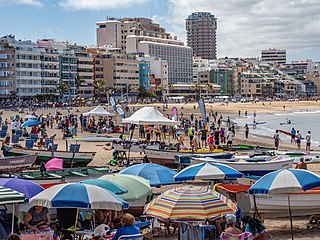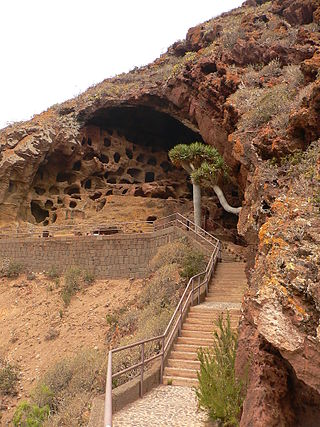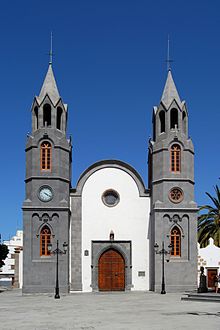
Las Palmas, officially Las Palmas de Gran Canaria, is a Spanish city and capital of Gran Canaria, in the Canary Islands, in the Atlantic Ocean.

Gran Canaria, also Grand Canary Island, is the third-largest and second-most-populous island of the Canary Islands, an archipelago off the Atlantic coast of Northwest Africa and is part of Spain. As of 2023 the island had a population of 862,893 that constitutes approximately 40% of the population of the archipelago. Las Palmas de Gran Canaria, the capital of the island, is the biggest city of the Canary Islands and the ninth of Spain.
Binter Canarias S.A. is the flag carrier of the Spanish autonomous community of the Canary Islands, based on the grounds of Gran Canaria Airport in Telde, Gran Canaria and Tenerife North Airport, San Cristóbal de La Laguna, Spain. It is a regional air carrier operating inter-island services within the Canary Islands, and other Atlantic islands, it also operates to the Spanish Mainland and some European destinations, mainly in France and Italy. Affiliated airlines operate on behalf of Binter in services to Morocco, Mainland-Spain, Portugal and Western Sahara.

Valsequillo de Gran Canaria is a town and a municipality in the eastern part of the island of Gran Canaria in the Province of Las Palmas in the Canary Islands. Its population is 9,170 (2013), and the area is 39.15 km².

Ingenio is a town and a Spanish municipality in the eastern part of the island of Gran Canaria in the Province of Las Palmas in the Canary Islands. Its population is 29,978 (2013), and the area is 38.15 km2 (14.73 sq mi).

Gran Canaria Airport is a passenger and freight airport on the island of Gran Canaria. It is an important airport within the Spanish air-transport network, as it holds the sixth position in terms of passengers, and fifth in terms of operations and cargo transported. It also ranks first of the Canary Islands in all three categories, although the island of Tenerife has higher passenger numbers overall if statistics from the two airports located on the island are combined. The facility covers 553 hectares of land and contains two 3,100m runways.
Navegacion y Servicios Aéreos Canarios, better known by its initialism NAYSA, was a regional airline based in Las Palmas, Gran Canaria, Spain. It operated scheduled and charter flights, as well as cargo flights, air taxis, air ambulance flights and crew transfers. Its main base was Gran Canaria International Airport.

The Diocese of San Cristóbal de La Laguna, also called Diocese of Tenerife or Diocese Nivariense, is a diocese located in the city of San Cristóbal de La Laguna in the Canary Islands and a suffragan in the ecclesiastical province of the Archdiocese of Sevilla in Spain. The diocese includes the islands of Tenerife, La Palma, La Gomera and El Hierro, in the province of Santa Cruz de Tenerife. The bishop of this diocese is Bernardo Álvarez Afonso.

Canary Fly, S.L., doing business as Canaryfly, is a Spanish airline that operates regular flights between the Canary Islands.
Pintaderas are a form of stamp used by the pre-Hispanic natives of the Canary Islands. They were commonly made of fired clay. However, a number of wooden pintaderas have also been found. Most pintaderas come from archaeological sites in Gran Canaria, although natives from other islands in the Canarian archipelago used them too. Pintaderas were usually decorated with ornate geometric shapes, including zigzags, triangles, rectangles, squares and circles. These decorative motifs are similar to those found on pre-Hispanic Canarian pottery. Similar geometric patterns can also be seen in pre-Hispanic Canarian rock art
The Lycée Français René-Verneau de Gran Canaria is a French international school in Telde, Gran Canaria, Spain. It was established in 1974 and has integrated the Mission laïque française (Mlf) in 1986. It serves levels maternelle (preschool) through terminale, the final year of lycée and it allows French, English and Spanish languages learning from preschool for all children. As of 2017 the school has about 400 students range from 3 to 18 years.

The Hospital Universitario Insular de Gran Canaria is a teaching hospital of general scope in Gran Canaria. Located in the city of Las Palmas de Gran Canaria, it was founded 13 February 1971 and consists in February 2021 of 503 beds. The first patient was hospitalized 20 September 1971.

Valerón's "monastery" is an archaeological site on the Spanish island of Grand Canary, in the municipality of Santa Maria de Guia, on Valerón's cliff. It is the largest pre-Hispanic collective granary built before Roman times and used by the island's inhabitants until the conquest of the island at the end of the 15th century.

The Guayadeque ravine, in Spanish Barranco de Guayadeque, is a ravine-type valley located on the Spanish municipalities of Ingenio and Agüimes, in the province of Las Palmas on Grand Canary island, off the coast of Morocco.

The Painted cave is an archaeological museum and park in the town of Galdar, located the northwest of Grand Canary in the Canary Islands, Spain. This centre is part of the Spanish Ministry of Culture, Historic Heritage and Museums of the town council of Grand Canary.
The following is a timeline of the history of the city of Las Palmas, Canary Islands, Spain.
As in the rest of Spain, the majority religion in the Canary Islands is the Catholic Church. The Catholic religion has been the majority since the Conquest of the Canary Islands in the fifteenth century. This religion would largely replace the Canarian aboriginal religion through the prohibition of the latter and syncretism. According to a survey conducted in 2019, Canary Islands is the fifth autonomous community in Spain with the highest percentage of people who declare themselves to be Catholics after the Region of Murcia, Extremadura, Galicia, Aragon, and Castile and León. 76.7% of the population is Catholic.
Gregorio Chil y Naranjo was a Spanish doctor, historian and anthropologist.

El Museo Canario is an archeological museum in Las Palmas, the capital city of Gran Canaria in the Canary Islands. It is dedicated to the pre-colonial history of the Canary Islands.


























